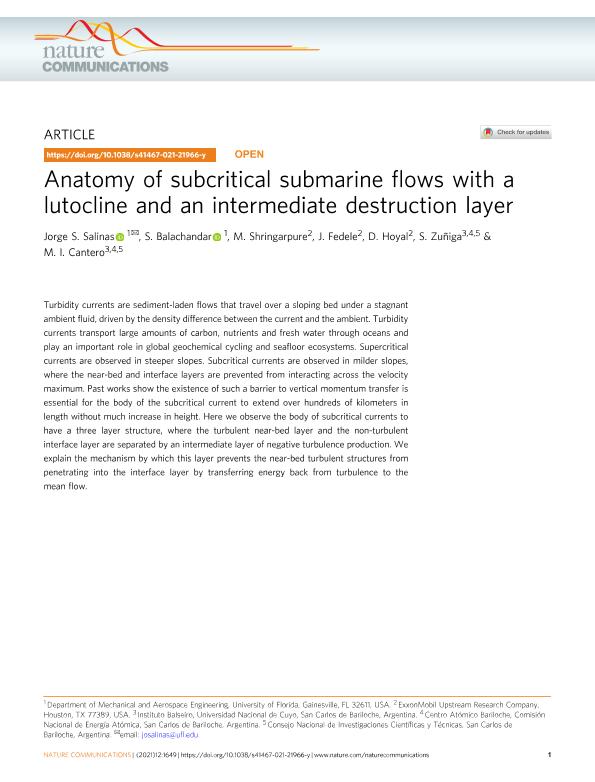Mostrar el registro sencillo del ítem
dc.contributor.author
Salinas, Jorge Sebastián

dc.contributor.author
Balachandar, S.
dc.contributor.author
Shringarpure, M.
dc.contributor.author
Fedele, J.
dc.contributor.author
Hoyal, D.
dc.contributor.author
Zúñiga, Santiago Luciano

dc.contributor.author
Cantero, Mariano Ignacio

dc.date.available
2022-09-06T12:20:37Z
dc.date.issued
2021-12
dc.identifier.citation
Salinas, Jorge Sebastián; Balachandar, S.; Shringarpure, M.; Fedele, J.; Hoyal, D.; et al.; Anatomy of subcritical submarine flows with a lutocline and an intermediate destruction layer; Nature; Nature Communications; 12; 1; 12-2021; 1-11
dc.identifier.issn
2041-1723
dc.identifier.uri
http://hdl.handle.net/11336/167505
dc.description.abstract
Turbidity currents are sediment-laden flows that travel over a sloping bed under a stagnant ambient fluid, driven by the density difference between the current and the ambient. Turbidity currents transport large amounts of carbon, nutrients and fresh water through oceans and play an important role in global geochemical cycling and seafloor ecosystems. Supercritical currents are observed in steeper slopes. Subcritical currents are observed in milder slopes, where the near-bed and interface layers are prevented from interacting across the velocity maximum. Past works show the existence of such a barrier to vertical momentum transfer is essential for the body of the subcritical current to extend over hundreds of kilometers in length without much increase in height. Here we observe the body of subcritical currents to have a three layer structure, where the turbulent near-bed layer and the non-turbulent interface layer are separated by an intermediate layer of negative turbulence production. We explain the mechanism by which this layer prevents the near-bed turbulent structures from penetrating into the interface layer by transferring energy back from turbulence to the mean flow.
dc.format
application/pdf
dc.language.iso
eng
dc.publisher
Nature

dc.rights
info:eu-repo/semantics/openAccess
dc.rights.uri
https://creativecommons.org/licenses/by/2.5/ar/
dc.subject
turbid underflow
dc.subject
turbidity current
dc.subject
gravity current
dc.subject
turbulence
dc.subject.classification
Oceanografía, Hidrología, Recursos Hídricos

dc.subject.classification
Ciencias de la Tierra y relacionadas con el Medio Ambiente

dc.subject.classification
CIENCIAS NATURALES Y EXACTAS

dc.title
Anatomy of subcritical submarine flows with a lutocline and an intermediate destruction layer
dc.type
info:eu-repo/semantics/article
dc.type
info:ar-repo/semantics/artículo
dc.type
info:eu-repo/semantics/publishedVersion
dc.date.updated
2022-08-30T20:01:35Z
dc.journal.volume
12
dc.journal.number
1
dc.journal.pagination
1-11
dc.journal.pais
Estados Unidos

dc.description.fil
Fil: Salinas, Jorge Sebastián. Consejo Nacional de Investigaciones Científicas y Técnicas; Argentina. University of Florida; Estados Unidos
dc.description.fil
Fil: Balachandar, S.. University of Florida; Estados Unidos
dc.description.fil
Fil: Shringarpure, M.. No especifíca;
dc.description.fil
Fil: Fedele, J.. No especifíca;
dc.description.fil
Fil: Hoyal, D.. No especifíca;
dc.description.fil
Fil: Zúñiga, Santiago Luciano. Comisión Nacional de Energía Atómica. Gerencia del Área de Energía Nuclear. Instituto Balseiro. Archivo Histórico del Centro Atómico Bariloche e Instituto Balseiro | Universidad Nacional de Cuyo. Instituto Balseiro. Archivo Histórico del Centro Atómico Bariloche e Instituto Balseiro; Argentina. Consejo Nacional de Investigaciones Científicas y Técnicas. Centro Científico Tecnológico Conicet - Patagonia Norte; Argentina
dc.description.fil
Fil: Cantero, Mariano Ignacio. Comisión Nacional de Energía Atómica. Gerencia del Área de Energía Nuclear. Instituto Balseiro. Archivo Histórico del Centro Atómico Bariloche e Instituto Balseiro | Universidad Nacional de Cuyo. Instituto Balseiro. Archivo Histórico del Centro Atómico Bariloche e Instituto Balseiro; Argentina. Consejo Nacional de Investigaciones Científicas y Técnicas. Centro Científico Tecnológico Conicet - Patagonia Norte; Argentina
dc.journal.title
Nature Communications

dc.relation.alternativeid
info:eu-repo/semantics/altIdentifier/doi/http://dx.doi.org/10.1038/s41467-021-21966-y
Archivos asociados
